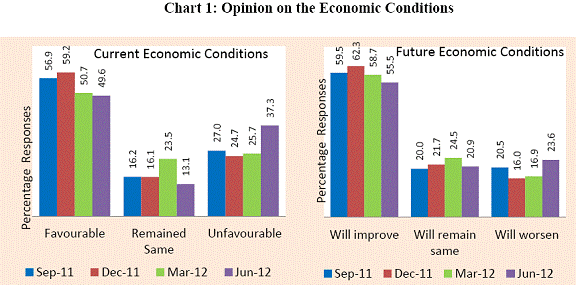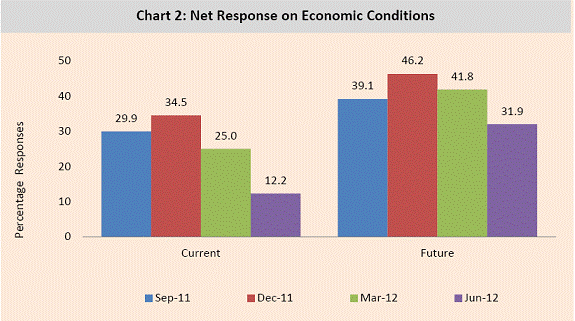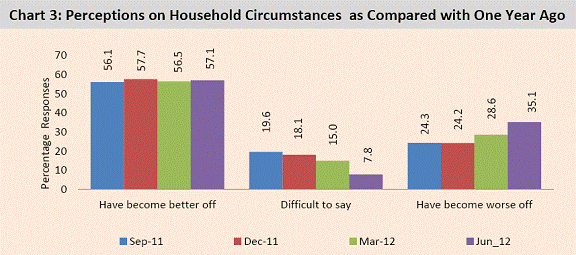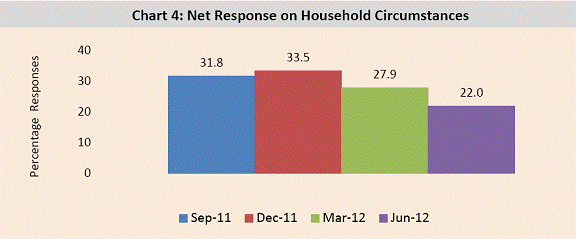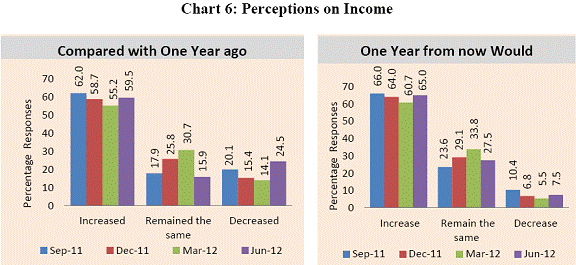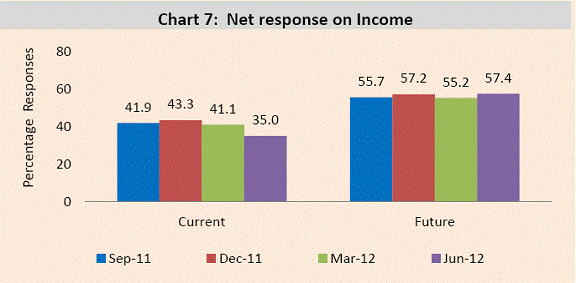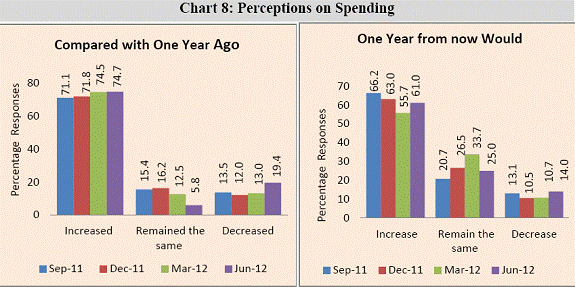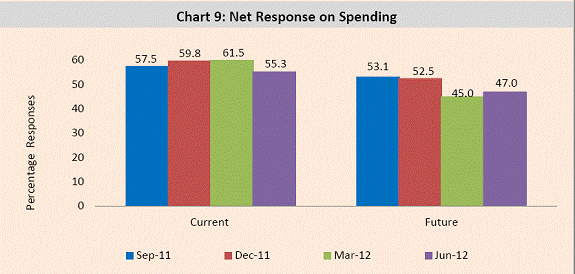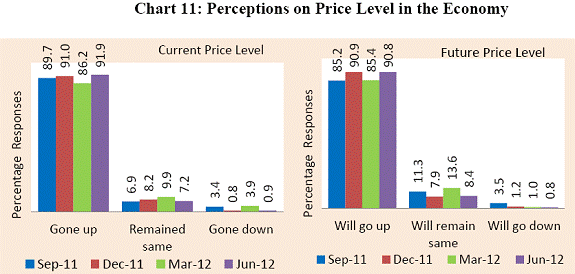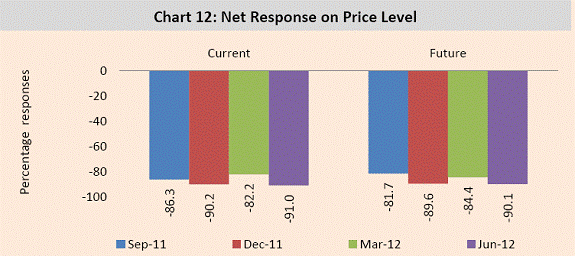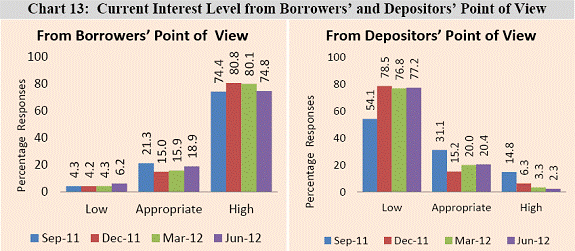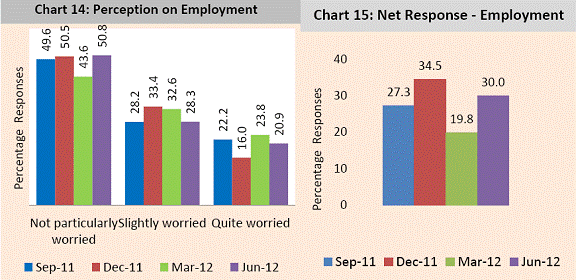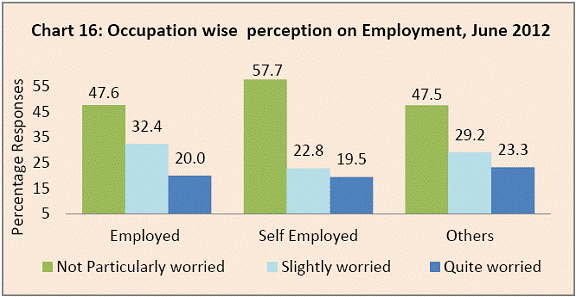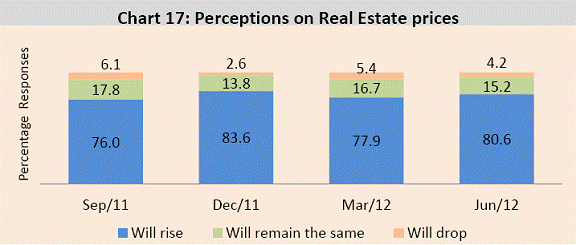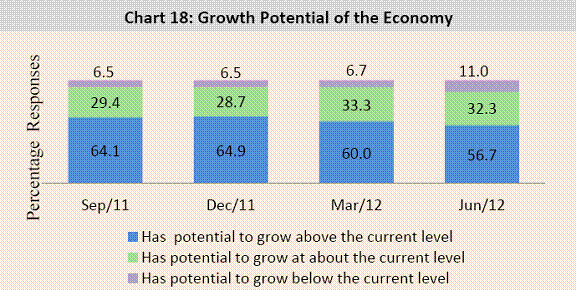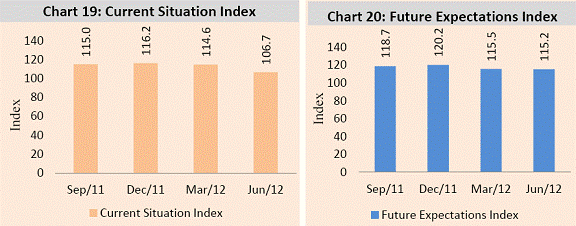This article presents the salient findings of the Consumer Confidence Survey conducted in June 2012, the 9th round in the series. It provides an assessment of the consumer sentiments of the respondents based on their perceptions of the general economic conditions and their own financial situation. The assessments are analysed in two parts, viz., current situation as compared with a year ago and expectations for a year ahead.
The survey indicates that households’ perception about current economic conditions and future expectation for next one year have fallen in terms of net response; however, about half of the respondents continue to feel that the current and future economic conditions are favourable. Though majority of respondents have perceived better-off household circumstances, the proportion of respondents reporting worsening household circumstances has increased which led to decline in net response on household circumstances. The net response on current income has declined, whereas the same relating to future income has marginally increased. The net response on current spending has decreased. About half of the respondents reported ‘not particularly worried’ about the employment prospect leading to an improvement in net response. Overall the current situation index has dropped from 115 to 107, while future expectations index remained at around 115 as in the last quarter.
I. Introduction
The Reserve Bank has been conducting the Consumer Confidence Survey for obtaining the qualitative information since June 2010 on quarterly basis. The 9th round of the survey was conducted in June 2012.
II. Sampling Design
The survey covers six metropolitan cities, viz., Bengaluru, Chennai, Hyderabad, Kolkata, Mumbai and New Delhi. Each city is divided into three major areas and each major area is further divided into three sub-areas. From each sub-area, about 100 respondents are selected randomly. For each round of survey, 5,400 respondents are selected (900 respondents from each city). For the current round, out of the total 5,400 survey schedules, 5,189 schedules were found to be suitable and thus were included in the survey results.
III. Structure of the Survey Questionnaire*
The survey schedule consists of qualitative questions pertaining to impression about economic conditions, views on household circumstances, perceptions on price level, employment prospects and developments in real estate prices and views on growth potential of the Indian economy.
IV. Survey Results: Key Highlights
IV.1 Economic Conditions
- About half of the respondents have reported economic conditions to be favourable as compared with a year ago and about 56 per cent have reported that the economic conditions will be favourable in the next one year (Chart 1).
- There is a shift in responses from ‘remained same’ (neutral) to ‘unfavourable’. This shift has led to a fall in the net-response on economic conditions (Chart 2).
IV.2 Household Circumstances
- Though majority of the respondents have perceived that `household circumstances have become better off’, the proportion of respondents reporting `worsening of current household circumstances’ has increased (Chart 3). As a result, net response on household circumstances has declined to 22 per cent in this round (Chart 4).
- Among the respondents who has perceived change (better-off/worse-off) in household circumstances as compared with one year ago, around 85 per cent have reported ‘salary and business income’ as a main factor for change in household circumstances (Chart 5). Other important factors leading to change in household circumstances are ‘price level’ and ‘interest and dividend income’.
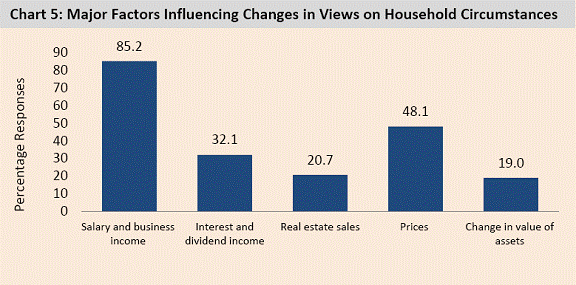
Note: As respondents may report multiple factors, total of percentage relating to factors may be more than 100.
IV.3 Income
- The proportion of respondents reporting ‘increase’ in current as well as future income has risen in this round after a decline over the last four rounds (Chart 6).
- The rise in responses of ‘decrease in current income’ as compared with one year ago has resulted in the decline of the net response on current income in June 2012 as compared with March 2012. However, the net response for future income has increased marginally (Chart 7).
IV.4 Consumer Spending
-
Around three-fourths of the respondents have reported increased spending in the current year as compared with the previous year (Chart 8). The proportion of respondents with neutral position regarding perception on spending, (i.e. ‘current spending remains same as compared to a year ago’ / ‘future spending will remain same’) has decreased noticeably in this round.
-
There is a noticeable rise in the share of respondents who intend to increase spending in the next year as compared to the last round. However, there is also an increase in share of respondents with intention of decreasing spending in the next year.
- Net response on the perceptions on current spending as compared with a year ago has decreased (Chart 9). However, net response on future spending after declining over the last three quarters has shown a marginal increase.
- Among the respondents who have perceived change (increase/decrease) in their spending as compared with a year ago, around 89 per cent have reported ‘current income’ as a main factor for influencing the spending (Chart 10). Other important factors leading to influence in spending are ‘cost of consumer goods’, ‘future income’ and ‘cost of services’.
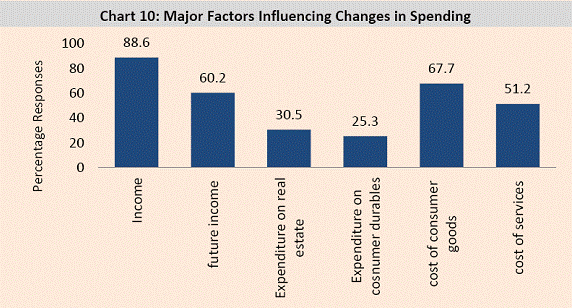
Note: - As respondents may report multiple factors, total of percentage relating to factors may be more than 100.
IV.5 Price Level
- More than 90 per cent of the respondents have felt that prices will continue to increase during the next year (Chart 11).
- As the negative perceptions on the current and future price levels have increased, the net responses on price levels of both have deteriorated (Chart 12).
IV.6 Perceptions on other Macroeconomic Indicators
IV.6.1 Interest Rates
-
About three-fourths of the respondents have reported that interest rates are high from borrower’s point of view. However, about 19 per cent of respondents have felt the rate is appropriate (Chart 13).
-
From the depositors’ point of view, about 77 per cent of the respondents have felt that the rate is low. About 20 per cent of the respondents are of the view that the current interest rates are appropriate.
IV.6.2 Employment Conditions
-
About half of the respondents have reported ‘not particularly worried’ about the employment prospects (Chart 14).
-
The share of respondents worried about employment prospects has moderated as compared to the previous round. As a result, net response has increased in the current round (Chart 15).
IV.6.3 Future Developments in Real Estate Prices
- The proportion of respondents expecting a rise in future real estate prices continues to remain around 80 per cent (Chart 17).
IV.6.4 Growth Potential of the Economy
- Majority of respondents have perceived that Indian economy has potential to grow above the current level in the long run (Chart 18).
IV.7 Current Situation Index and Future Expectations Index
-
Current Situation Index (CSI), based on current perception of economic conditions, household circumstances, income, spending and price level, after moving in a narrow band of 114-116 during the last four quarters has dropped to 107 in this round (Chart 19).
-
All the indicators pertaining to e conomic conditions, h ousehold c ircumstances, i ncome, s pending and p rice l evel contributed to the fall in CSI.
-
The Future Expectations Index based on future expectations of economic conditions, income, spending, price level and employment prospects has remained at the same level in June 2012 as compared with previous quarter (Chart 20).
|











